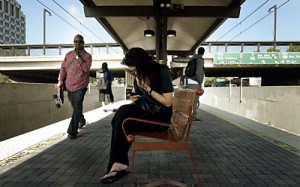SPECIAL REPORT: Higher gas prices create boon for Gold Line ridership
Link: http://www.iwillride.org/?p=1017Posted by Rodrigo

People make use of the Metro Gold Line at Lake Station in Pasadena Tuesday morning, April 26, 2011. Metro officials say 3,000 more people per day rode the Gold Line this March as compared to March 2010, a 10 percent increase as gas prices topped $4 a gallon in Los Angeles County. (SGVN/Staff Photo by Sarah Reingewirtz)
By Hector Gonzalez, Staff Writer
05/01/2011 06:05:31 PM PDT, Whittier Daily News
Gold Line riders at a glance
Average daily ridership (weekdays) on the Gold Line has steadily increased during the past five years, reaching a new high of more than 35,000 riders last month, according to Metro ridership figures:
- 2006: 16,778
- 2007: 18,776
- 2008: 20,514
- 2009: 23,681*
- 2010: 31,829
*The Eastside Extension opened in November 2009. Metro officials believe the opening helped spike ridership.
PASADENA – As the price of regular gas broke above $4 a gallon in Los Angeles County in March, ridership on Metro’s Gold Line reached a new high, climbing 10 percent compared to March 2010, transit officials said.
Not surprisingly, that’s been the trend almost since the $859 million, 13.7-mile rail line from Pasadena to Union Station opened in July 2003: Each spike in gasoline prices since then has corresponded with jumps in the Gold Line’s average daily ridership.
This year ridership increased from 31,544 in March 2010 to 35,544 in March 2011 – 3,000 more riders per day on average than in 2010, and 10,000 more than in March 2009, Los Angeles County Metropolitan Transportation Authority numbers show.
For the first time, the Gold Line has consistently surpassed its original daily ridership projections of 26,000 to 32,000.
And it follows the gas/ridership correlation. In March, the average gallon price for self-serve regular passed $4 in Los Angeles County for the first time since June 2008, when it hit an all-time record of $4.63 a gallon.
In June 2008, Gold Line ridership spiked – from around 18,000-20,000, where it had hovered throughout 2006 and 2007, to about 26,300.
It’s riders such as George Cabado, who was taking the Gold Line home recently from his job in Pasadena to Boyle Heights, who have helped boost ridership by opting to ditch their cars for the train, transit officials said.
“No comparison,” Cabado said, displaying the $1.50 fare he paid to board the line at the Lake Avenue Station. “In my van I was spending $20 a day.”
At the same time, Cabado said, work in his construction field has dwindled, leaving him with mass transit as his cheapest commuting option.
MTA officials believe Gold Line ridership numbers would be much higher if not for the county’s pervasive 12percent unemployment rates, spokesman Jose Ubaldo said. Ridership on Metro’s still-forming rail system tends to reflect the number of people out of work, he said.
A look at ridership on Metro’s other rail lines shows it fell last month compared to March 2010, and that includes the Red Line, one the most heavily used. It saw a drop from 155,463 in March 2010 to 144,093 last month. Green Line and Blue Line ridership also decreased last month, MTA figures showed.
Those lines traverse areas of high unemployment, at or above the county average of 12 percent, including downtown and South Los Angeles. Pasadena’s unemployment rate, meanwhile, stood at about 9 percent.
“It’s a different story now than in 2008,” when sticker shock at the pump sent drivers in droves to mass transit, Ubaldo said. “Now, people are more used to the higher gas prices, but with the recession, a lot of people are not working. There are fewer people now who need to take the bus or train to work.”
But the Gold Line differs from Metro’s other rail lines in ways that have helped shield it from the impacts of the recession. The median yearly income of Gold Line users, for example, is about $42,500, compared to $11,250 for Red and Blue line transit users, according to a 2004 study by researchers at UCLA.





